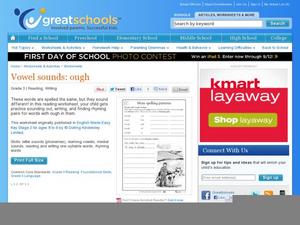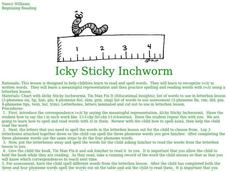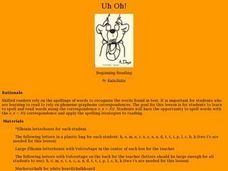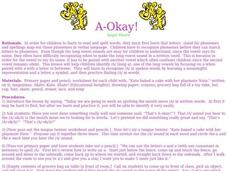Curated OER
Writing Bug - A Silly Vowel Story
In this writing worksheet, students are challenged to write a silly story in which every other word begins with a vowel. Students are encouraged to use a dictionary, be creative and check for spelling and grammar.
Curated OER
More Spelling Patterns
Pass the time...creating rhymes! Writers connect rhyming words with -ough in them, writing them as rhyming pairs. Next, they put their poetic skills to the test by applying the words in rhyming couplets. There is an example...
Curated OER
Match the Rhymes
Tree, bee, knee, three... what do these have in common? Focus on vowel sounds in this matching worksheet for beginning readers. Learners connect a picture of a tree to pictures that rhyme with it and then get some printing practice. All...
Curated OER
Odd One Out
There is one object that doesn't belong in each of these sets. Scholars circle the one that doesn't rhyme, listening for the /o/ vowel sound (long and short) in the others. They connect two of the objects to printing practice,...
Curated OER
Match the Rhymes
Explore CVC words with the vowel sound a to give pre-readers a grasp of rhyme. They draw lines from a van to surrounding pictures that rhyme (man, pan, fan, can). Then, leaners get printing practice by tracing the words van...
Curated OER
Fraction Spelling
An interesting take on spelling practice is included here! Emerging spellers take their weekly spelling list and create a three-column chart. In the first column, they write the word itself. In the second column, they write how many...
Curated OER
Sound Practice 1
Practice reading and identifying various vowel blends and spelling patterns. Each slide contains a vowel combo sound, and a word containing that sound. Learners will practice vowel blank e, /oi/, /oa/, and /oi/ sounds.
Curated OER
THE BLENDING SLIDE
Your beginning readers will practice blending sounds with this hands-on activity! Each learner gets their own paper slide, cards with consonants, and cards with vowels. Then, after practicing as a class, they can blend consonant and...
Curated OER
Alexander said Achoo
Alexander asked for ashy amber apples! Have your young learners practice the /a/ sound with this tongue twister. Then learners will write the letter and participate in a book talk for A Cat Nap. Can they identify the target...
Curated OER
Icky Sticky Fingers
Practice recognizing the short vowel /i/ in written and spoken language. Introduce the target sound with a fun tongue twister about Lizzy the lizard. Through matching and listening activities, learners discriminate the vowel sound /i/...
Curated OER
Say /o/
Ollie the octopus is occupied! Use this tongue twister to help youngsters learn the /o/ sound. After practicing the target sound, learners should print the letter. When they are familiar with the letter and its sound, the group will...
Curated OER
Icky Sticky Inchworm
Use the meaningful example "Icky Sticky Inchworm" to demonstrate the /i/ sound. Then have learners take out letter boxes and spell simple words like six, lip, him, pin, slim, grin, etc.
Curated OER
Aches and Pains
Being able to distinguish between short and long vowel /a/ sounds is an important skill for young readers. They are introduced to the vowel-consonant-e pattern that changes short vowel sounds into long vowel sounds. They practice reading...
Curated OER
Uh Oh!
Help your elementary learners distinguish between short and long vowel /o/ sounds. They are introduced to the vowel-consonant-e pattern that changes short vowel sounds into long vowel sounds. Then they practice reading and spelling words...
Curated OER
A-Okay
Learners distinguish between short and long vowel /a/ sounds. They are introduced to the vowel-consonant-e pattern that changes short vowel sounds into long vowel sounds. Then they practice identifying words with the...
Curated OER
Amazing As
Help young readers recognize the short vowel /a/ in written and spoken language. Through matching and listening activities, they discriminate the vowel sound /a/ from other phonemes. Learners associate the phoneme with its letter...
Curated OER
Say Aaaah
Using letter boxes and a series of activities, young learners will identify the /o/ sound. Give them the fun tongue twister before having them manipulate letters in the letter box, and then read In the Big Top. Can your learners...
Curated OER
Open Up And Say Ahh
Who has a word that has an /o/? Teach kids this fun song (sung to the tune of "Skip to My Lou") to remember the /o/ sound and words that contain the target sound. Then have learners identify the sound in various words before...
Curated OER
The Pronunciation of Regular Verbs in the Past Exercise
Give your class experience with pronunciation. This learning exercise has learners place the given verbs ending in /-ed/ into columns based on the final sound, then state the rules for pronunciation. This is a more advanced activity and...
Curated OER
Scanning Worksheet: Latin
Introduce your Latin class to meter and the metrical pattern of an elegiac couplet. Have your learners practice identifying the syllables open to resolution in the two exercises provided. Answers are not included, but there is a helpful...
Curated OER
Magic Vowel Spider Web
In this long I words worksheet, students read ten clues to words containing the long I sound. Students color the spaces containing the answers in a spider web.
Curated OER
Spelling Activities
Use this list of spelling activities all year long to help your class spell each week's list of words! This list provides 12 different ways for class members to practice their spelling. Learners identify vowels, consonants, synonyms, and...
Curated OER
Word Washer Vowels
Here is a perfect activity for all your kinesthetic learners. They practice long and short vowel discrimination as they hang out the paper articles of clothing on a clothes line. They each take turns pulling word clothes out of a pretend...
Curated OER
Learning About Vowels - Part One
Help learners examine the vowels as the teacher writes them on the board. They watch as the teacher circles the vowels. Then they can complete a worksheet where they circle the vowels in the given words.

























